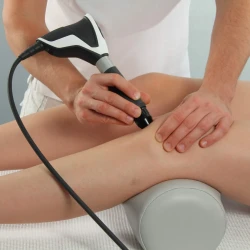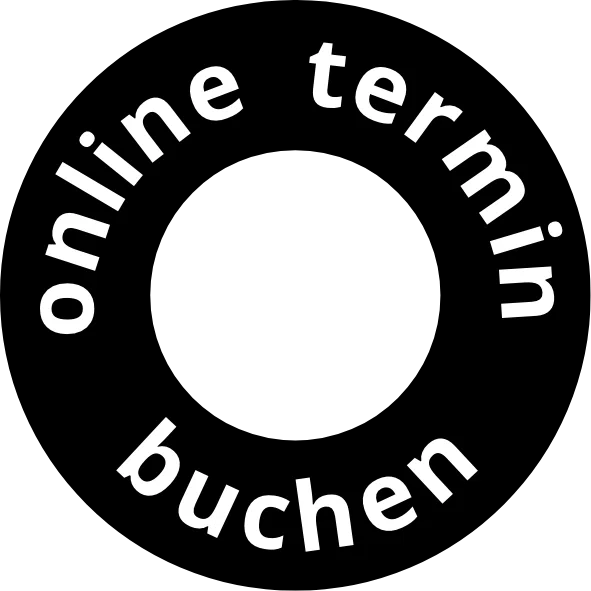Treatment of heel pain, heel spurs and plantar fasciitis:
Heel pain can be a very painful and agonising condition. The underlying diagnosis is usually a heel spur or plantar fasciitis and, along with metatarsalgia (forefoot pain) and hallux valgus, is one of the most common foot problems of all. The diagnosis can usually be made by the orthopaedist based on the patient's medical history and a thorough examination. Initial pain in the morning after getting up or after prolonged sitting is often the first complaint. Sharp, initially localised pain on exertion is the main symptom; pain at rest or at night from which the affected person wakes up is rather rare.

Book a consultation appointment now!
A quick, simple and easy way to your appointment.
Chronic plantar fasciitis is behind the heel spur
In most cases, this heel pain is due to chronic inflammation/irritation of the plantar fascia. The plantar fascia is a strong tendon plate that stretches the sole of the foot and extends from the heel to the toes, essentially forming the arch of the foot. With every step and when standing, the plantar fascia is stretched and is subject to high mechanical stress. A weak point of this system is usually the attachment to the heel bone, so that chronic inflammation can develop here, leading to heel pain, foot pain or even pain in the Achilles tendon area.
How does this inflammation of the plantar fascia or heel spur develop?
This type of inflammatory irritation of the plantar fascia can be triggered by overloading. In most cases, however, no single triggering cause can be identified. There is usually a chain of unfavourable factors behind it. It often begins with pelvic twisting due to an SI joint block or a block in the lumbar spine, which results in a so-called functional leg length discrepancy. This functional leg length discrepancy causes one foot to be overloaded with every step. This leads to recurrent micro-injuries in the fascia and thus represents a chronic inflammatory stimulus with shortening of the fascia. In most cases, as with achillodynia (painful Achilles tendon), there is also a shortened calf musculature with active trigger points, which obviously also leads to additional strain on the plantar fascia.
For these reasons, after osteopathic or manual therapy treatment of the pelvic-leg chain and shock wave treatment, the compensation of an anatomical leg length difference or pelvic obliquity and self-exercises for stretching and fascia treatment of the calf and plantar fascia also play a decisive role in eliminating the pain.
What significance does the bony heel spur have as a trigger for heel pain?
The heel spur is a bony protrusion on the lower calcaneal tuberosity at the base of the plantar fascia. The heel spur develops as a calcification due to overuse of the tendon insertion or an inflammatory stimulus. It can only be visualised by X-ray and has no pathological value on its own. Even in pain-free patients, it can be detected in 10-20% of the population and, conversely, half of patients with heel pain do not have a bony heel spur. For these reasons, after osteopathic or manual therapy treatment of the pelvic-leg chain and shock wave treatment, the compensation of an anatomical leg length difference or pelvic obliquity and self-exercises for stretching and fascia treatment of the calf and plantar fascia also play a decisive role in eliminating the pain.
Treatment of heel pain, heel spurs and plantar fasciitis:
The therapy is made up of various components. It begins with a manual therapeutic osteopathic treatment to compensate for a functional difference in leg length. The focus here is on the treatment of functional disorders in the lumbar spine, pelvis, knee and tarsal bones as well as the treatment of active trigger points in the calf and foot muscles. An essential part of the therapy concept is also the consistent and daily implementation of the self-exercise programme and extracorporeal shock wave therapy (ESWT).
The most effective combination for heel spurs and plantar fasciitis: self-exercise and shock wave therapy (ESWT)
In a large number of studies, focused shock wave therapy has proven to be by far the most effective treatment method for treating plantar fasciitis and heel spurs as a supplement to the patient's own exercise programme. It reduces fascial inflammation and leads to faster healing of micro-injuries. This requires 4-6 treatments at 1-2 week intervals.
You can download the self-exercise programme here: Self-exercises-plantar fasciitis heel spur
Supplementary treatments to reduce tension and pain from plantar fasciitis and heel spurs:
The following additional treatments can also be used:
classic orthopaedic and/or sensorimotor insoles, a night splint, kinesio taping, acupuncture, cryotherapy and injection therapy. (regenerative injection; never cortisone)

